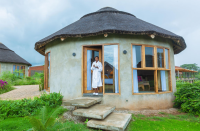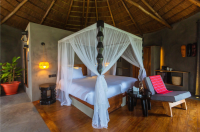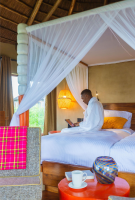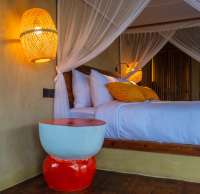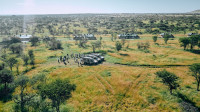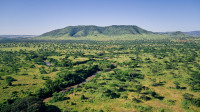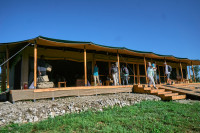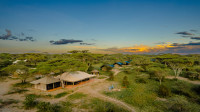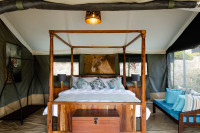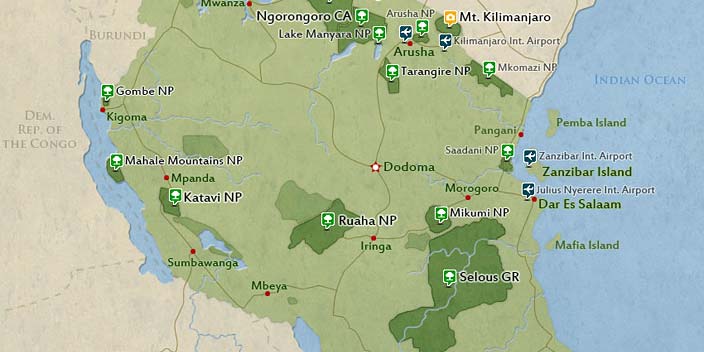
$2,200 pp (USD)
2 travelers on Start dateArrival
Arrival

Day 1
Tarangire National Park
Tarangire National Park
Breakfast will be served at the lodge and thereafter we will depart to Tarangire National Park. The park is named after the Tarangire River which runs through it. This ‘river of warthogs’ is the only source of water for wildlife in the region during the dry season. In places, the vegetation is quite dense, including elephant grass, acacia woodlands, and lush groundwater forest. The park is well known for its elephant families, which can often be seen congregating by the river. You may also see giraffes, bushbuck, and hartebeest. These animals are closely followed by a range of predators, including lions and leopards There are more breeding species of birds found in Tarangire National Park than anywhere else on the planet! After a packed lunch and an extensive drive.
- Main Destination:
- Tarangire National Park
- Accommodation:
- Suricata Boma Lodge
- Meals & Drinks:

Day 2
Central Serengeti National Park
Central Serengeti National Park
After finishing up a good breakfast, you will head out towards the Serengeti National Park and travel in the midst of the never-ending plain grasslands. The Serengeti is arguably the most impressive wildlife sanctuary in the world. You will have an afternoon game drive in the endless plains of the Serengeti for a chance to see the great herds of wildebeest, zebras, and gazelles or a pride of lions lounging in the shade. A picnic lunch will be done during the day-long game drive itself The endless variety of landscape explains the diversity of wildlife to be seen during a Serengeti Central Safari with AfricanMecca. Volcanic in origin, the terrain has weathered over time to form distinctive areas. The low hill ranges contain black clay pans, which support acacia trees and the giraffe that browse on them.
- Main Destination:
- Serengeti National Park
- Accommodation:
- Land of Nature Camp
- Meals & Drinks:

Day 3
Serengeti National Park To Ndutu
Serengeti National Park To Ndutu
A safari in the Southern Serengeti is all about seeing the Great Migration in action on daily game drives, whether it’s baby wildebeest being born and taking their first steps on the lush green plains in the early months of the year, or watching the vast herds on the move as they track their course northwards towards the Masai Mara. The Southern Serengeti is one of the places where you can see the full circle of the Great Migration: the herds returning to graze in December with the start of the green season, the birth of the babies in January and February, and the departure of the herds as the grass starts to dry at the end of the rains.
Due to the seasonality of game viewing in the Southern Serengeti, there are only a few permanent lodges in the region, as well as one permanent tented camp. There are several mobile camps, ranging from affordable to luxury, that are open during the months of the Great Migration.
- Main Destination:
- Ndutu (Southern Serengeti NP)
- Accommodation:
- Ang'ata Migration - Ndutu Camp
- Meals & Drinks:

Day 4
Ndutu
Ndutu
A more energetic day might begin with an early morning bush breakfast during a game drive in one of many distinct landscape areas within the Ndutu Conservation Area: marshlands, acacia woodlands, soda lakes of Ndutu and Masek or the vast expanse of the Serengeti plains are all within easy reach – each with its distinct wildlife populations and seasonal visitors. The marsh areas for example are favoured by big cats to bring up their young, whereas the short grass plains are where Wildebeest babies are born during the Great Migration As the sun lowers. Or raise a glass or two around the bar to share stories and make new friends. As you return to your cottage full of good food and vivid memories from the day, listen for the haunting call of a hyena echoing through the woodlands before the velvet night brings a restful sleep. Ndutu is in an area without tsetse fly ensuring a peaceful stay.
- Main Destination:
- Ndutu (Southern Serengeti NP)
- Accommodation:
- Ang'ata Migration - Ndutu Camp
- Meals & Drinks:

Day 5
Ngorongoro crater To Arusha
Ngorongoro crater To Arusha
On the last day of your safari, you will have an early start. Finishing up with a quick breakfast you will make an early descent at around 6:30 AM into the crater floor. The Ngorongoro Crater is the world’s largest inactive, intact, and unfilled volcanic caldera. It has a massive floor of about 260 sq km with a depth of over 2000 feet. The 5-hour game drive on the crater floor will show you a lot of animal action. Keeping the camera ready is definitely recommended. The African elephant, buffalo, Black rhino, Hippos, Hyenas, Cheetahs, and Lions are found in plenty. Post the picnic lunch at the beautiful Hippo pool, you will begin a steep ascend to the top exit of the crater. This is the last leg of your safari, with a 4-hour drive left to Arusha. You will be dropped off at your preferred location in Arusha by 6:00 PM in the evening. With an incredible experience and loads of memories to cherish, this is the time you bid goodbye to your team.
- Main Destination:
- Ngorongoro Crater
- Accommodation:
- No accommodation (End of tour)
- Meals & Drinks:















